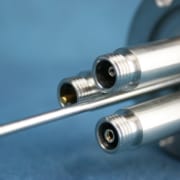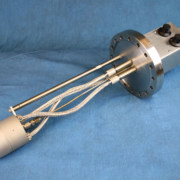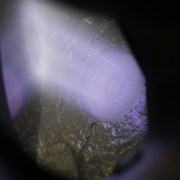September 2023 Newsletter
Hello from Colorado! We hope everyone has enjoyed their summer activities with their families and friends.
It was a busy summer at Plasma Process Group, and we are doing our best to work toward shorter lead times for delivery of the common consumables. We owe our successes to our customers. We can’t thank you enough for supporting us.
Tech Tips – Ion Source Water Cooling Issues
Why is my water interlock not met?
Many of us in the field of optical coatings and ion beam deposition know that many RF ion sources require water flow for cooling. Water is usually cooling both the source shroud and the RF antenna. They normally run in series with the water supply entering directly through the antenna first, then through the shroud before returning to a chiller or closed loop water cooling system.
The Polyethylene water lines to the RF antenna feed through require electrically isolative tubing to keep your RF power from transmitting to ground through the tubing. Always be aware that this tubing needs to be 7 feet long or longer for both supply and return of the RF feedthrough.
There are a few things to be aware of with your cooling system. First, is making sure your water is non-conductive so RF power can’t get to ground. The goal is to be as close to 7 megaohms as possible. (As measured from the feedthrough to ground). Second, make sure the pH level is as close to 7 as possible to minimize corrosion and electrolysis. Just remember “777”. Lastly, flushing your cooling system biannually or annually at a minimum, to reduce mineral and algae build up in the cooling system.
Some of you may have experienced leaks outside your chamber from the Polyethylene tubing that supplies water to your source for cooling. If your water flow is blocked or restricted the poly tubing can weaken, burst and your source will overheat. If you run the source with no water flow, the same results can occur when the water is finally engaged.
There are other causes of issues like this such as a bad water flow limit switch. We have seen them stay on even when there is no water flow and eventually melt the poly tubing at the feedthrough. Much of this issue can be avoided by following maintenance protocol. We certainly urge you to do planned maintenance over letting it slide till it fails.

Ion source water restriction
Now for the issue we don’t think you would have thought about. Can you guess what the image above is? If you guessed Polyethylene tubing, you are correct. The poly tubing itself can be a source of failure as well and require maintenance.
This image shows two ends of the poly tubing that were cut off from the entry and exit side of the RF feedthrough connection points of a 16cm RF ion source. The piece on the left with the most restricted center is from the return line side and the one on the right is the supply line.
This restriction is actually not residue or corrosion. It is the poly material itself after many cycles of heat and cold from operation. It has slowly deformed. It can happen if your flow is too low. The Poly will break down and shrink over time. The supply side stays relatively normal because the heat cycles are far less variable or extreme. As you can see, the one on the left is almost completely plugged. In this case the flow switch was working on the system and finally indicated that flow was restrictive enough to send an alarm to the operator that there was not enough cooling to meet the interlock setpoint.

Ion source water restriction
One key point here is to trust interlocks when you are not performing best maintenance practices. Waiting till something fails will commonly create more than one failure in your cooling system. This can lead to ongoing troubleshooting in your system by causing clogs in multiple areas and flow switch failures. In many cases, days of system downtime will follow.
With this Poly tubing issue, we outlined in the above images. The easiest and quickest maintenance step to solve this issue is to simply cut off a half inch of the poly with the ferrule on it and install a new ferrule for reconnection. This literally takes minutes and can keep your flow where it is supposed to be. How often you should do this depends on how proactive you are at doing your recommended maintenance. In this case the tubing restriction took about a year and a half with good maintenance practices.
Because some systems are using individual chillers, and some are using closed loop facility cooling systems, it is important for the maintenance technician to be aware of the issues with conductive water and RF power. Many chemicals are used to reduce algae and adjust pH levels. Sadly, almost all of them will affect conductivity of the water. RF will travel through water if conductive enough and you then lose RF power from your source. Be sure your team is aware of this when looking at adding chemical treatments to your cooling system.
Always follow maintenance protocol on your ion source cooling system. Remember “777”. 7 feet of poly tubing for both return and supply lines to your source RF feedthrough, 7 megaohms for conductivity of your water, and a pH level of 7 for your cooling water. Be sure to clean and flush your systems cooling lines through your source, target assembly and chamber walls. Biannually is recommended for worry free operation.
We hope this segment was beneficial for you and your team. We certainly want you to be successful and maximize your equipment uptime. Please be sure to contact us if you are in need of spare ion source parts, grids or power supplies. We’re happy to help.

Plasma Process Group Techne system operation
Plasma Optik Is Attending The SPIE LDT Conference
We are excited to be attending the SPIE Laser damage conference in Livermore/Dublin, California starting on the 17th of September. If you happen to be at the conference please be sure to look for us. This should be a great conference to attend for Plasma Optik. We look forward to being there.
Today, our Techne has exceeded many of the specifications we had only dreamt of reaching 1 year ago. Especially in the LDT arena. Plasma Optik has a variety of target materials available and is more than happy to discuss your needs when you are ready. Please contact Brett Buchholtz via email at [email protected] or give him a call today at 970-786-6218. He is happy to discuss your project with you.




